Prostatitis is an inflammation of the prostate gland that affects men aged 20 years and older.
According to statistics, 1 in 4 men have experienced this disease in one form or another. In recent years, there has been a constant tendency to "rejuvenate" the process. This is due to sexual liberation, an increase in sexually transmitted infections, tendencies towards self-diagnosis and treatment on the Internet and the resistance of infectious agents to the action of antibiotic therapy.
This is especially true because the first signs of prostatitis in men, as a rule, are expressed erased, which does not allow to consult a doctor in time and in some cases leads to the development of advanced prostatitis.
Signs of prostatitis in men
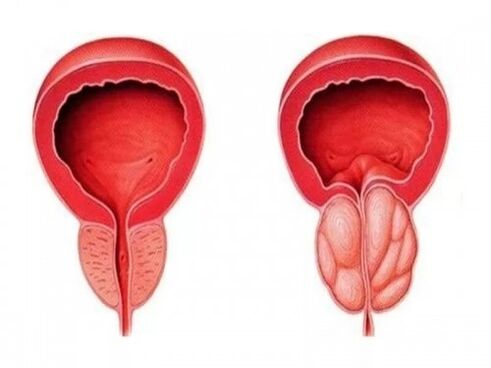
The characteristics of the structure, blood supply, and location of the prostate gland affect the nature of the symptoms that will lead to its inflammation. This includes:
- Pain symptom.
- Symptoms of urinary incontinence (dysuric).
- Symptom of erectile dysfunction.
Pain symptom
Sensations of pain, varying in intensity, bother the person in the lower abdomen, in the perineum, genitals, lumbosacral spine. This location of pain is due to the presence of neural connections and the involvement of the seminal vesicles (bladder) in the inflammatory process.
The pain can vary in intensity, from an unexplained feeling of discomfort to severe pain that affects a man’s mental state and causes insomnia. Painful sensations depend on sexual behavior and arise from the lack of regular ejaculation or, conversely, ejaculation, which is associated with the spread of the inflammatory process in the posterior urethra.
Note that pain in the lumbosacral region may not be associated with the prostate gland in any way, but may be the result, for example, of osteochondrosis of the spine. The result of a conversation with the patient and urological examination data help determine the cause of such pain.
The first sign of prostatitis in a man is the sensation of pain in the testicles (in the scrotal area) with spreading along the epididymis (right and left groin areas). Pain radiating from an inflamed prostate may appear in the inner thighs, which dictates the need to consult a neurologist to rule out neurological pathology, as it is precisely for prostate pain that such a spread is not typical.
In some cases, the radiation of painful sensations is asymmetric, which makes it possible to suspect an inflammatory process in the prostate, located in one of its lobes. At the site of manifestation, pain syndrome is divided into genital organs (in the genital area, characteristic of chronic congestive prostatitis), extragenital (above the genitals), characteristic of advanced prostatitis) and mixed (chronic prostatitis).
Symptoms of dysuria or prostate urinary incontinence
Urinary disorders are expressed by false desire, a feeling of incomplete emptying of the bladder with frequent urination, which is accompanied by inflammation in the neck of the bladder and urethra. Permanent signs of dysuria in the prostate indicate the chronology of the process.
Erectile dysfunction with the prostate

Erectile dysfunction in the prostate is represented by premature ejaculation, vague sensations during orgasm, decreased libido, weakening of the erection. Sometimes a man's prostate can be suspected of lack of erections in the morning.
A decrease in potency, as the first sign of prostatitis in a man, is caused by a decrease in the synthesis of testosterone (male sex hormone).
Manifestations of inflammation in the prostate gland are not limited to the above three symptoms. Often the first sign of prostatitis in a man is the discharge of prostate secretion from the urethra during the act of defecation (prostatorrhea), which shows a decrease in the muscle tone of the ejaculatory ducts.
In addition, we can not fail to focus on the psychological signs of prostatitis in a man: asteno-neurotic syndrome develops from the nervous system (depression, fatigue, lack of desire to do anything, physical weakness).
The first signs of acute prostatitis
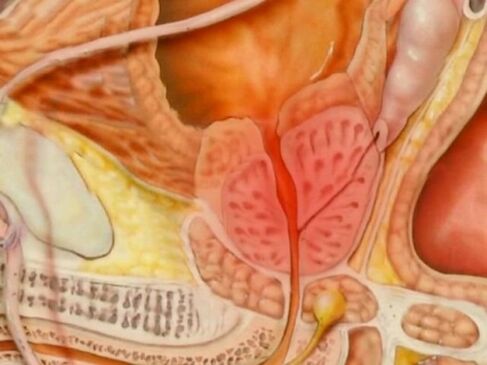
All of the above symptoms are typical of chronic inflammation in the prostate, with acute prostate in a man, the appearance is somewhat different.
The disease begins with severe acute pain in the perineum, the symptoms of urinary disorder are traced more clearly. There is a rise in temperature to 38-39 C, chills, weakness, sweating, muscle and bone pain. When you defecate, the pain in the anus bothers you. There is no sex life.
If you do not pass the exam in time and do not start treatment, then the acute process will be complicated by purulent prostatitis, up to an abscess, which will lead to an urgent operation.
If there are no other reasons (immunodeficiency condition, severe concomitant pathology, etc. ) - purulent prostate in a man - an advanced inflammatory process due to premature access to a doctor!
Causes of signs of prostate inflammation
Factors affecting inflammation in the prostate were conventionally divided into 3 groups.
Factors that do not respond include:
- Body type.
- Sexual constitution.
- Age factor.
- Presence of diseases.
- Environment (climatic factor).
Partly controllable factors:
- Sexual habits.
- OCCUPATION
- Background diseases of the male genital area.
- Attitude towards the disease.
And finally, the controllable factors:
- Spoiled sex life.
- Alcoholism.
- Non-compliance with treatment recommendations.
- Errors in the way of power supply.
Who is at risk
Prostatitis threatens men who:
- Adhere to a sedentary lifestyle.
- Suffer from chronic constipation.
- Have a history of venereal infections.
- Have more than one sexual partner.
- Suffer from alcoholism, drug addiction.
- They work in cold conditions.
If there are signs of prostatitis, what to do
Laboratory diagnosis for prostate
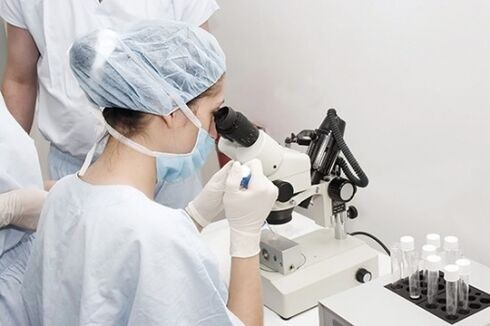
- In the KLA, an increase in the erythrocyte sedimentation rate, a shift in the leukocyte formula to the left. In OAM - leukocyturia, proteinuria, bacteriuria.
- Blood for HIV infection.
- A stain from the urethra on the flora. As a rule, in the stain, the leukocytes are completely. If a venereal pathogen (Neisser gonococcus, Trichomonas) is not identified, PCR diagnosis is necessary.
- Prostate gland secretion Planting of prostate secretion in the pathogen and determination of antibiotic susceptibility.
- PCR - diagnosis for sexually transmitted infections. The most reliable and fastest way to verify the pathogen.
- Blood for PSA Blood for PSA (prostate specific antigen) should not be taken during an acute inflammatory process in the prostate gland, the result will be unreliable. Analytically it is better to do this analysis 1 month after the end of therapy. It is not necessary for young people under 30 to examine the level of PSA in the blood. This test is important for a man over 40, as acute prostatitis, in some cases, can be secondary, and a malignant tumor in the prostate gland is masked behind its clinical manifestations.
Instrumental diagnostic methods
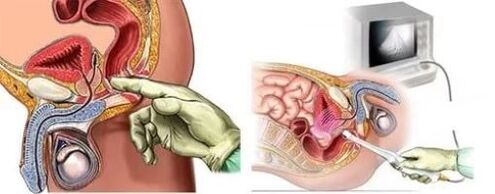
As a rule, a transverse (through the rectum) or transabdominal (through the abdomen) ultrasound examination of the prostate is sufficient.
Signs of prostatitis on ultrasound
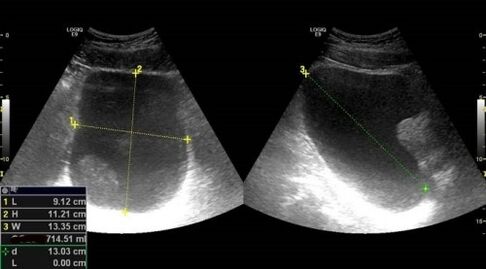
An increase in gland in volume, a change in quality, edema; with purulent prostate - areas of necrosis, contour deformation, an increase in regional lymph nodes.
What to pay attention to
First of all, to get rid of prostate symptoms permanently, you need to follow a certain diet.
Worsening of prostatitis in a man depends on irritating substances ingested with food: hot spices, vinegar, pickles, alcohol.
Special mention should be made of alcohol, even its minimal use can nullify the effects of complex long-term therapy.
Some patients feel that they need to drink less often or switch to lighter alcoholic beverages. This is their main mistake.
Diluted vinegar, kvass, citrus fruits, sauerkraut, tomatoes and cucumbers have no harmful effect on the prostate.
Eating foods rich in fiber will relieve a person from constipation - one of the main reasons for the development of congestion in the small pelvis.
Herbal medicine helps well for prevention. Taking herbal diuretics: cranberry leaf, fennel seeds, urological collection helps to improve urination during inflammation.
Exercises, especially physical exercises to improve blood circulation to the pelvic organs, help keep the prostate in good shape.
The development of inflammation in the prostate provokes hypothermia. In winter it is worth dressing warmer, and in summer, after swimming, you should not be on wet swimming trunks for long.
Using condoms during sexual intercourse with an unknown partner will protect you from sexually transmitted diseases, including HIV infection.
Prolonged fatigue has a negative effect on a man's immune system, as well as stressful situations, which can intensify a dormant infection in the prostate gland. Regular preventive examination by a urologist will help maintain men’s health.



























